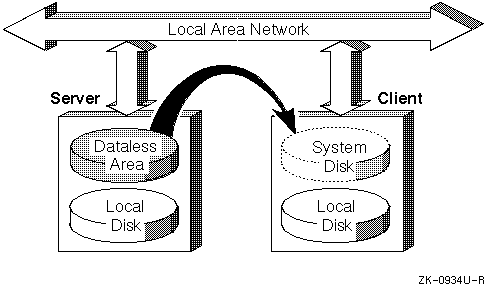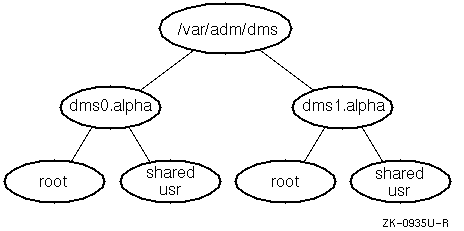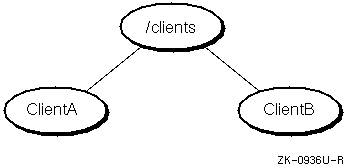This chapter describes Dataless Management Services (DMS), the dataless management utility (dmu), the requirements for setting up a DMS environment, and the relationship between DMS servers and clients.
In a dataless management services (DMS) environment, a server system maintains the root, /usr, and /var file systems for all client systems. The server maintains one copy of root for each client. The /usr file system is exported read only and is shared by all clients registered to the environment. Client systems have their own /var file system. All swapping and dumping is done on the client's local disk.
The dataless management utility (dmu) creates a root file system based on the software subsets installed in the DMS environment area on the server. This root file system is accessed by client systems over a Local Area Network (LAN). DMS lets system administrators customize the root and /usr file systems before client systems access them.
You must have superuser privileges to perform many of the dmu functions.
The advantages of installing DMS are:
The DMS utility, dmu, manages the sharing of installed operating system software between servers and clients in a LAN. In addition to the server's normal disk area, one or more disk partitions are reserved as the DMS area. The DMS area is made up of one or more product environments and client areas.
In the DMS area, the server maintains multiple copies of the root area, one for each client. Each copy is in a client root directory in the DMS area and is customized for the client in order to provide for differences between hardware platforms or environmental requirements. Each of the client root directories is private; this means that there is a directory for each client so that no conflict or confusion exists between clients. The server's DMS root and /usr areas are made available to clients by means of the Network File System (NFS). For more information about the NFS used by Digital UNIX systems, refer to the Network Administration guide.
Beyond verifying clients' identities, vectoring their boot requests, and providing their system disk space, the server does not interact directly with the clients. The server can, if desired, support local timesharing users and need not be dedicated to DMS.
A DMS client's system disk space ( root and /usr areas) is physically connected to the server instead of to the client. The client accesses that disk area through a LAN connection with the server. Each DMS client is booted across the network from its private root area on the server. Once booted, the client continues to use its root files and /usr files from the server's DMS area. These files appear to the client as if they were on local disks, as shown in Figure 9-1.

As indicated in Figure 9-1, clients must have local disks. In addition to local disks, clients can import file systems from any other computer to which they have network access. Clients use swap and dump space on their local disks.
One or more DMS environments can reside in a partition. If you want to prevent the dmu utility from putting all DMS environments in the same disk partition, indicate a unique mount point for each DMS environment. The DMS environment disk space requirements should be calculated using the worksheets in appendix B. Then the mount point of ./dmsn.alpha should be added to /etc/fstab.
Each DMS environment contains a customized Digital UNIX file system consisting of root, /usr, and /var. The dmu utility copies the root area to the client area when a client is added to the dataless environment.

Figure 9-2 shows the /var/adm/dms portion of a DMS area, it contains two DMS environments, dms0.alpha and dms1.alpha. Each DMS environment contains a root and /usr file system. The root file system is copied to each client system. The /usr file system is read only and is shared among all client systems registered to the environment.
The root file system contains copies of the kernel, .vmunix, vmunix and other primary system files. These primary files can be in either new form (files supplied in the Digital UNIX distribution kit and prefixed with .new..) or in prototype form (files prefixed with .proto..).
The .new.. version of a file should never be customized.
The .proto.. files have special significance for DMS environments. By modifying the .proto.. files, the DMS server system administrators can customize the system to meet their specific needs. These customized .proto.. files are used during the configuration of the server's DMS client environments. Standard files (such as /etc/hosts and /etc/fstab for example) can be modified so that clients do not have to modify them.
The /usr file system contains common files that can be used without being tailored by clients registered to the DMS environment.
DMS environments can be created with many different combinations of products to allow servers to provide diversified service based on client's software product needs. For example, you could have a DMS environment with only the base Digital UNIX Version 4.0 operating system and another DMS environment with the Digital UNIX Version 4.0 operating system plus any number of additional products installed (such as System V, DECLadebug, DEC Fortran, and so on). Multiple environment areas can be established in separate partitions to support a greater variety of different environments, improve performance, or support more clients than allowed by the disk space available in /var/adm/dms.
The server does not use any of the DMS area. System administrators can access the DMS area as required for maintenance and for installation or removal of layered products, but the area is not used by the server itself.
A DMS client area for individual client systems also resides in a DMS area. Figure 9-3 shows a DMS client area, named /clients. The /clients area should most likely be located on its own partition after the size of the area is calculated using the worksheets in Appendix B. Then, the mount point of /clients should be added to the /etc/fstab file.

Multiple copies of the root file system reside in the client area, one for each client, tailored from the appropriate generic root file system. Each client builds a customized kernel, which resides in the client's root area if the client has a Partial or Full build environment. This customized kernel supports the client's actual system configuration, including central processor, system memory, and peripheral devices. Figure 9-3 shows two client root areas, named ClientA and ClientB. Each client sees its private root area and the shared /usr area from the appropriate /var/adm/dms environment as local, although these areas are actually on the server and are accessed through NFS. Figure 9-4 shows how clients share /usr and have their own root file system.
Multiple client areas can be established but must reside in different partitions.
Clients do not have access to the entire DMS area. Each DMS client has access to the root area assigned to it on the server.
Common system files residing in the /usr area are shared among all the clients registered to that particular /var/adm/dms environment. Mounted with read-only access for the clients, this shared area is protected from erroneous client activity. Figure 9-4 illustrates this concept.

In Figure 9-4, the small boxes represent what the clients think they see; the arrows show how the real disk areas on the server are mounted by the client to produce this view.
Clients can be timesharing systems or workstations. Because each client's root area is tailored specifically to the client's needs and would contain the software the client can run, there is no interference between clients attempting to use identical resources that could, for example, have licensing restrictions based on the number of concurrent users.